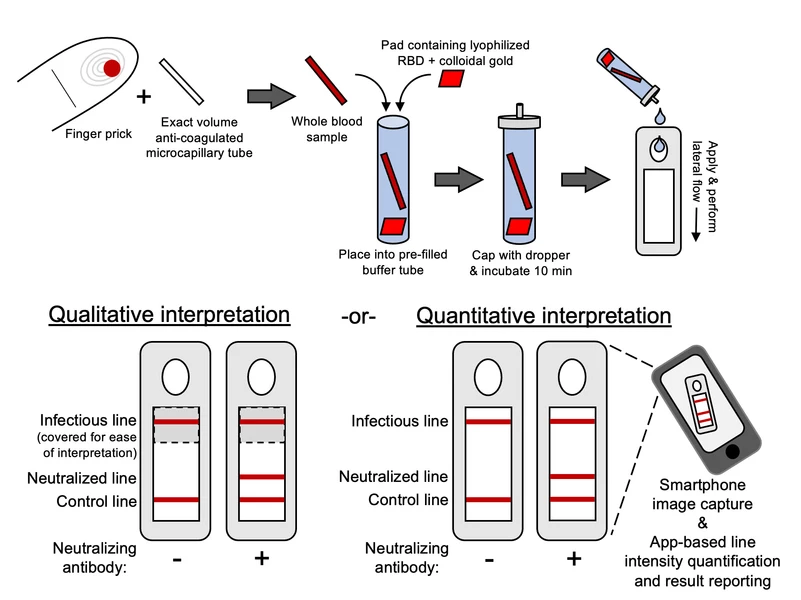An innovative new test developed by researchers at MIT promises to offer people the ability to quickly and easily measure their COVID-19 immunity. The test tracks levels of neutralizing antibodies in a drop of blood, helping a person evaluate their susceptibility to SARS-CoV-2 infection.
Following vaccination or SARS-CoV-2 infection, measuring levels of neutralizing antibodies in blood samples has proven to be a useful way of quantifying a person’s immunity. Traditionally it takes specialized lab equipment to measure antibody levels in a given blood sample but early on in the pandemic a team of MIT researchers wondered if an easy at-home test could be developed to do the same job.
The researchers looked to lateral flow test technology, the same system used in now popular at-home rapid COVID-19 tests. Unlike the currently available rapid antigen COVID tests, this new antibody test requires a tiny blood sample.
The prototype test kit presented in a new study comes with a finger-prick device to obtain a drop of blood that is then transferred to a dropper containing specific reagents. These reagents contain SARS-CoV-2 viral proteins tagged with microscopic gold particles.
The idea is that antibodies in a person's blood sample will interact with these gold-tagged viral proteins, so when drops of the mixed sample are placed on a test strip those proteins captured by antibodies will light up a positive line.

Going one step further than simply delivering a positive or negative signal, this antibody test is also hoped to give users the ability to quantify their immune response. Using an accompanying smartphone app, the researchers propose to measure the intensity of the line, allowing for antibody levels to be quantified in a given sample.
Of course, a crucial point to note is that neutralizing antibodies are just one part of a complex and multifaceted immune system response to viral infections. While research over the last couple of years has effectively found antibody levels to be a decent correlate of protection from infection, this metric does not offer insights into protection from severe disease.

Antibody responses often rapidly drop in the months after vaccination or natural infection but that doesn’t mean a person is not protected from severe disease. From this standpoint, the new MIT test will only really be useful in a limited number of contexts. Hojun Li, one of the lead investigators on the project, says the primary use target will be tracking immune responses in vulnerable populations, such as those undergoing chemotherapy or suffering from autoimmune disease.
“… I think where this test might make the biggest difference is for anybody who is receiving chemotherapy, anybody who’s on immunosuppressive drugs for rheumatologic disorders or autoimmune diseases, and for anybody who’s elderly or doesn't mount good immune responses in general,” explained Li. “These are all people who might need to be boosted sooner or receive more doses to achieve adequate protection.”
Identifying those vulnerable subjects with low antibody levels can allow for extra layers of protection, such as masking, to be implemented. The research team is currently looking to partner with a manufacturer to bring the test to market.
The new study was published in the journal Cell Reports Methods.
Source: MIT




